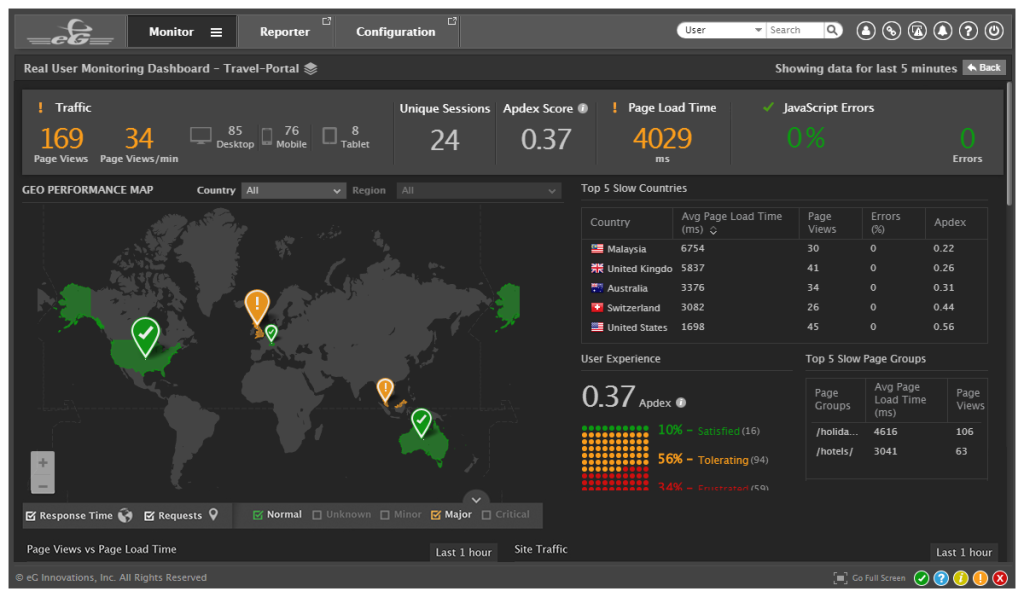Understanding Application Performance Monitoring
At its core, Application Performance Monitoring (APM) is a comprehensive approach to guarantee that software applications deliver the expected service level. APM systematically gauges various performance indicators, including but not limited to load times, transaction rates, user satisfaction, and overall service availability.
This vigilant monitoring ensures that any anomalies can be swiftly detected and remedied, thus maintaining the integrity of the user experience.
Understanding APM begins with recognizing its key components, which form a robust toolkit for any IT professional. This suite comprises an array of analytics tools designed to monitor application performance, from front-end user interfaces to back-end databases and network infrastructure.
Integrating these components with your company’s broader IT systems creates a seamless workflow for continuous performance optimization.
Benefits of Application Performance Monitoring
APM offers many benefits beyond the IT department, influencing user satisfaction and the bottom line. By implementing cutting-edge monitoring tools, companies can expect a significant reduction in application downtime and increased system reliability.
This warning system allows quicker response times, preventing potential issues from escalating into user-impacting problems. At the heart of these benefits is the ability to enhance the user experience profoundly, ensuring that every transaction is slick, every page loads quickly, and app interactions are seamless.
Beneath the surface, application performance management also contributes to strategic business planning. The metrics gathered through comprehensive monitoring are valuable for predicting user trends, understanding behavior, and planning infrastructure changes that can foster business agility and growth.
As organizations strive for efficiency, APM can be the tool that delivers deep insights into the cost drivers of IT operations and helps minimize them without compromising on service quality.
Key Features of a Robust APM Tool
A well-equipped APM tool should possess a combination of versatility and depth, designed to provide IT teams with a 360-degree view of application performance. Real-time monitoring is a cornerstone feature, ensuring the tool continually watches over application behavior and generates alerts at the first sign of trouble.
To go along with this, deep-dive diagnostics allow tech teams to dissect and pinpoint the root cause of problems, even in the most complex, multi-layered application environments.
These baseline features, a comprehensive APM solution should also offer end-to-end transaction tracing, which follows user interactions throughout all levels of the application stack.
This ensures that every problem can be traced to its genesis point, whether within the code, the network, or the servers. Furthermore, compatibility with various environments—from cloud-based platforms to on-premises systems—is essential for ensuring the tool provides broad coverage across the IT landscape.
Executing an APM Strategy
Implementing APM is not simply a matter of technology; it’s about aligning the correct tools and practices with business goals and technology objectives. When executed correctly, an APM strategy can significantly enhance IT operational efficiency, reduce issue response times, and align technology performance with business processes.
To achieve such alignment, it’s imperative to consider the nuanced insights from leading industry experts, highlighting the importance of a holistic view that includes user satisfaction metrics within performance goals.
Application Performance Monitoring Trends
Emerging technologies and shifting industry practices constantly shape the landscape of APM. Infiltrating artificial intelligence (AI) and machine learning into APM tools brings unprecedented automation, adjusting thresholds and alert systems with a precision that uncannily predicts performance issues.
This revolution underpins a broader trend, where APM evolves from a purely reactive toolset into a proactive guardian of application health, anticipating challenges and facilitating rapid, data-driven decisions.
Choosing the Right APM Solution
Selecting an APM solution that aligns with an organization’s unique needs and business objectives is a significant decision. Factors to consider include ease of integration, depth of analytics, the scale of monitoring capabilities, the vendor’s track record, and the level of support provided.
The process requires a nuanced understanding of the various APM products on the market and matching features with the business’s specific performance, user experience, and operational efficiency goals.
Future of Application Performance Monitoring
The following chapters of APM will likely be written with the ink of advanced predictive analytics and integration with broader business intelligence functions.
APM tools are envisaged to address existing performance concerns and foresee and navigate potential future scenarios that could impact user experience and business continuity.
This will further cement APM’s role as a critical component of an organization’s digital ecosystem, influencing development cycles, IT operations, and strategic business decisions.
APM: Beyond Technology
The influence of APM extends beyond the boundaries of technology into corporate culture, particularly regarding how different teams within an organization communicate and collaborate.
Successful APM practices encourage synergy and shared understanding between IT, development, and business operations teams, ultimately fostering an environment where the pursuit of an exceptional user experience is a unifying goal across the enterprise.
Practical Tips for APM Integration
Effectively integrating APM within a company’s current systems begins with a structured approach encompassing project planning, system audits, and staff training.
This journey requires careful consideration of technical and cultural aspects, which are equally crucial for adopting and optimizing APM practices. Strong emphasis on measurement, reporting, and continuous improvement ensures APM’s long-term value and alignment with business objectives.

